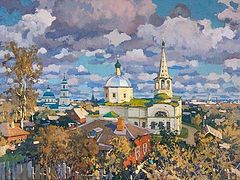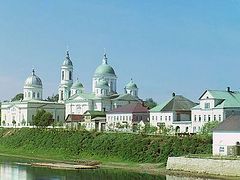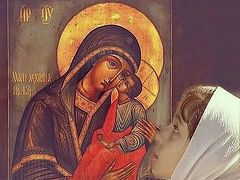Dmitry Nechitaylo, award-winning artist of the Russian Federation, member of the Artists Trade Union of Russia and the Union of Russian Writers, speaks on pilgrimage and art, creative genius and responsibility, genuine art and professionalism.
On the sense of the beautiful
—Exhibitions of paintings by classics such as Isaac Levitan, Valentine Serov, and Ivan Aivazovsky attract a multitude of visitors in Moscow. The audience is diverse—there are many families and young people among the comers. According to my personal observations, these people have nothing to do with art. But they wait for hours in line, sometimes outside in the cold. Do you think it is an attempt to follow a fashion?
—It is a sign that people are not indifferent, that their hearts are trembling, and the sense of the beautiful is awake! The work of world-famous artists amazes and delights them. We would queue to see the paintings by Valentine Serov, Nikolai Ge, Mikhail Nesterov, Leonardo da Vinci and the Impressionists. People are yearning for this beauty…
—Is this sense of the beautiful inherent with all people?
—You are quite right. But all depends on one’s upbringing. The ancient Russian word for “upbringing” - “vospitanie”, literally means “sublime spiritual nourishment”. It is necessary to instill love of the beautiful in children, take them to exhibitions and show them illustrations of Russian folk tales by Victor and Apollinary Vasnetsov and Ivan Bilibin. They need to absorb the original paintings in museums instead of the “goggle-box” and the computer.
—Why is visiting museums so important? After all, anybody can look at reproductions in albums or online.
—Unlike originals, reproductions don’t convey the author’s message fully. The master’s personality is always of primary importance. Thus in the museum you will meet the master, see his temper and the strokes of his living brush. When my mother [Maria Vladimirovna Savchenkova (1917-2017), People’s Artist of Russia—A. B.] was in Germany, she came up to one painting and said: “This is not Hans Holbein!” The guide led her aside and admitted: “We have our doubts about that, too.”
—Does classical art need to be promoted and propagated?
—Definitely! Through holding exhibitions, printing albums and postcards. It is conducive to the development of taste. For example, The Young Artist magazine used to have the column, School of Fine Arts. We should shoot and show films on the creative work of outstanding masters based on real facts (regrettably, sometimes there are blunders). For this we need to seriously delve into the material and the specifics.
—You are not only a painter. The publication of your books on other painters is underway. Please, tell us about this.
—Currently, I am waiting for the first book, Wondrous and Marvellous, to be published. It embraces the experiences from the Renaissance masters, the Impressionists, the Itinerants [a late nineteenth-century Russian school of Realist painters], the World of Art [a Russian artistic movement which largely helped revolutionize European art in the first decade of the twentieth century] to Modern Realism. I’ve been trying to demonstrate the uniqueness, skill and beauty of each author. The second book is entitled, The Sense of the Sea. My daughter Polina [Polina Dmitrievna Nechitaylo is a Russian theater and cinema actress, poet, and member of the Union of Russian Writers—A. B.] and I have been travelling across Russia and the Mediterranean—so these are our impressions. In this book I am responsible for paintings and poems, and my daughter is responsible for poems and drawings. At present we have just the layout of the book, but we are still looking for a publisher.
—What are the things that you cannot paint yet can commit to paper?
—The word is a Divine miracle in the movement of thought and song, while painting is a Divine miracle in the movement of thought and breath of color and light.
Creative work in the Name of God
—What is the most important thing in creative work for you?
—True, the creative process is very personal, but it is intended to carry some message. I seek to bear witness to Divine beauty on earth. For this I have been studying the methods, technology, and images of masters. Let us take St. Andrey Rublev, Daniel Cherny, Isaac Levitan, Vincent Van Gogh, Arkhip Kuindzhi (a Realist painter who had brilliant pupils), and Ivan Shishkin—a painter of exceptional skill who devoted special attention to nature as God’s creation.
—What is your message?
—To create in the Name of God… “Do Thou, O Master, Maker of all things, vouchsafe me to do Thy will in Thy true light and with enlightened heart”1.
—What can you say about the place of God in contemporary art?
—God is in all things—whether it is in art or life—at all times.
—How did you find your school?
—As our family friend, the brilliant sculptor Mikhail Pereyaslavets, said: “I am an orthodox Realist!” Like him, I abide by the principles of the high level of expertise and faithfulness to the traditions. I uphold the traditions of world and Russian national art—from Vasily Surikov and Arkady Plastov to my father [Vasily Kirillovich Nechitaylo (1915-1980), People’s Artist of the USSR, Corresponding Member of the Academy of Arts—A. B.]. My father was an exemplary master—he used to give me albums, pencils, boxes of paints, show me his pictures in the process of his work and give me instructions when I was receiving training. He was a real toiler and a man of remarkable moral purity. I joined him in his travels to the Vologda region, to the Don River, and other places, observing him work hard and dexterously. He would work on four paintings simultaneously every day. And, of course, I was also under a strong influence of my mother, who graduated from Moscow Surikov Art Institute and was a pupil of Igor Grabar.
—Your father painted the beauty of the southern regions of Russia, while you are attached to Russia’s North. Why did you make this choice?
—I developed a liking for this region in my student days—the spiritual and moral values, purity and self-sacrificing nature of northern people. I wrote my thesis entitled, The Beautifully Adorned Russian Land, amid the Valdai Hills2, on the banks of the Sukhona River, in Izborsk.
—Most of your canvases are large. Besides, you only paint landscapes directly from nature. Why?
—I take a big brush with wide sweeps and a big breath—it is called easel painting. Yes, I always paint from nature, asking my guardian-angel and Heaven to help me…
—How did you come to believe in God?
—My grandmother Xenia had me baptized when I was a child. I experienced a sort of enlightenment in the 1960s, when I was on Solovki collecting the material for my thesis on the Russian North. Tears were running down my face at the sight of the holiness of the monastery on the one hand, and the unlawfulness of the SLON (“Elephant”)3 labor camp on the other hand. And the meeting with Fr. Theophylact in Radonezh during the unveiling of a monument to St. Sergius transformed the lives of my talented family: my spouse Lyudmila and daughter Polina were baptized at the Holy Trinity-St. Sergius Lavra.
—Work was going well in that “prayer-soaked” place, wasn’t it?
—In holy places you feel your responsibility to God more keenly, you are more aware of the need for eternal life, and your experience and outlook are involved too.
—Do you feel more like a pilgrim or an artist there?
—An artist is already a pilgrim; acquiring beauty, he conveys it with prayer in his painting.
On genuine art
—Sometimes as you look at a painting, you cannot help but think: “What chaos was there in the soul of its painter?!” And you reject this picture with your heart. Have you ever had an experience like this?
—Genuine art can be recognized from its favorable influence on the soul. It’s when you rejoice and suffer together with the author—as in “The Song of the Wise Oleg”, “The Widow”, “Boyarynya Morozova”; the moral beauty of people—as in “Three Bogatyrs”; love for one’s motherland—as in “The Rooks Have Returned”… A painting that doesn’t touch your heart cannot be called a painting.
—In your opinion, which trends of art are edifying?
—All that is mere smoke on raw materials, or what soon “burns out” because it is intended just for show cannot be called edifying. I think that an abstract painting is pure fluff if its author is unable to paint and think realistically. Excesses make a painting saccharine, and insufficient training mutilates. It is everybody’s knowledge that both Salvador Dali and Pablo Picasso were masters of drawing despite all their “isms”.
—How to identify genuine, true art?
—Here are the criteria of genuine art: the school, professionalism, and responsibility. An artist shows both perfection and imperfection of life in his art. He first needs to experience, feel keenly and comprehend the idea and then convey it, using the arsenal of knowledge and skills.
—If a painter who has a desire for novelty is experimenting with the things that have not stood the test of time, how can you tell the false from the real?
—Tradition means passing your knowledge and skills on to your pupils. Innovation means moving forward with genuine art, in the context of the experience gained, with a conversation of your heart, while taking as much light as possible.
—For a painter his paintings are his bread and butter. How can he paint pictures that are to his taste and earn his living at the same time?
—The wonderful Alexey Savrasov created a lot of copies of “The Rooks Have Come Back” to make his bread. His masterpieces can be found in many museums. In the USSR there was “the Union of Painting and Design Art”: orders were allotted to painters all over the country, who would create paintings of good quality “in the field”. Unfortunately, there are no structures providing support to artists in our days, and you can hardly find an artist of Tretyakov’s genius among them.
—Are your works featuring Russian nature and Orthodox churches in high demand?
—You can find my paintings in museums and private collections both in Russia and abroad. For example, V. Meshalkin has collected around 100 of my paintings of Russian monasteries. Sadly, there are almost no sponsors and patrons in our days—the times of the Mamontovs and the Morozovs are yet to come. So we live from hand to mouth.
—You have huge experience in creative activity and spiritual life. What advice can you give to young artists?
—If you have a gift from above, use it properly and skillfully, and don’t lose it. You should treasure your school, strive for the perfection of great masters and exhibit your paintings as far as possible. An exhibition is a process of dialogue, a dimension of revelation. Cross yourself and start working with inspiration.
* * *
Reference
Dmitry Vasilievich Nechitaylo is a merited artist of Russia and member of the Union of Russian Writers.
He was born in Moscow on July 16, 1940. In 1967, he graduated from Surikov Art Institute in Moscow, the studio of the artist D. K. Mochalsky. He has been member of the Artists Trade Union since 1968.
His paintings can be found in museums and private collections in Russia, Europe, and America.
Contacts of Dmitry Nechitaylo’s studio:
Tel.: +7 (916) 238-28-31;
E-mail: polina@nechitailo.ru
The author’s online gallery (selected works):









